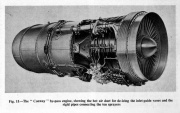Rolls-Royce Engines: Conway


Note: This is a sub-section of Rolls-Royce.
The Rolls-Royce RB.80 Conway was the first by-pass engine (or turbofan) to go into service in the world.
The jet found only limited applications in the Handley Page Victor, the VC10, the Boeing 707-420 and the Douglas DC-8-40. It started its flight development at Hucknall, Nottinghamshire. The Conway was developed and manufactured by Rolls-Royce. The name "Conway" is an Anglo-Saxon permutation of River Conwy, in Wales.
The Victor was also tested at Hucknall, together with the aircraft intake on one of the test beds. An Avro Vulcan was used to continue the development of the engine and also another new Rolls Royce engine, the Spey. The engines were located in the wing root of the Victor and in twin pods on either side of the rear fuselage of the VC10.
The largest Conways built were the RCo.42 and 43 which powered the Super VC10.
The Victor bomber was the first military application of the Conway engine. The contemporaneous V-bombers, the Valiant and Vulcan used the Rolls-Royce Avon and Bristol Siddeley Engines Olympus turbojet engines; defence reviews under Duncan Sandys curtailed development of manned military aircraft in favour of ground-launched guided missiles.
The engine found few civilian applications, as most airlines (especially US airlines) preferred to use US-built engines, and the Americans later developed a counter to the Conway, the Pratt & Whitney JT3D, which was less noisy and had a lower fuel consumption.
Engine variants (Variant - Relative Thrust- Aircraft)
- RCo.11 1.00 Handley Page Victor B.2
- RCo.12 Mk 508 1.01 707 With thrust reverser
- RCo.12 Mk 508A 1.04 707 Uprated Mk 508
- RCo.12 Mk 509 1.01 DC-8
- RCo.12 Mk 509A 1.04 DC-8 Uprated Mk 509
- RCo.17 1.19 Handley Page Victor B.2
- RCo.42 Mk 540 1.18 VC10
- RCo.43 Mk 301 1.26 VC-10 Military VC10
- RCo.43 Mk 550 1.26 Super VC10 8-stage LPC
See Also
Sources of Information
- [1] Wikipedia

